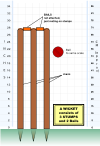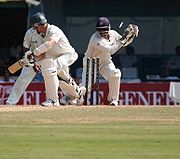.gif)
Stump (cricket)
Encyclopedia

Stump is a term used in the sport
Sport
A Sport is all forms of physical activity which, through casual or organised participation, aim to use, maintain or improve physical fitness and provide entertainment to participants. Sport may be competitive, where a winner or winners can be identified by objective means, and may require a degree...
of cricket
Cricket
Cricket is a bat-and-ball game played between two teams of 11 players on an oval-shaped field, at the centre of which is a rectangular 22-yard long pitch. One team bats, trying to score as many runs as possible while the other team bowls and fields, trying to dismiss the batsmen and thus limit the...
where it has three different meanings:
- part of the wicketWicketIn the sport of cricket the word wicket has several distinct meanings:-Definitions of wicket:Most of the time, the wicket is one of the two sets of three stumps and two bails at either end of the pitch...
- a manner of dismissingDismissal (cricket)In the sport of cricket, a dismissal occurs when the batsman is out . Colloquially, the fielding team is also said to have snared, bagged or captured a wicket. At this point a batsman must discontinue batting and leave the field permanently for the innings...
a batsman - the end of the day's play ("stumps").
Part of the wicket
The stumps are three vertical posts which support two bailsBail (cricket)
In the sport of cricket, a bail is one of the two smaller sticks placed on top of the three stumps to form a wicket. The bails are used to determine when the wicket is broken, which in turn is one of the critical factors in determining whether a batsman is out bowled, stumped, run out or hit wicket...
. The stumps and bails are usually made of wood, and together form a wicket
Wicket
In the sport of cricket the word wicket has several distinct meanings:-Definitions of wicket:Most of the time, the wicket is one of the two sets of three stumps and two bails at either end of the pitch...
at each end of the pitch
Cricket pitch
In the game of cricket, the cricket pitch consists of the central strip of the cricket field between the wickets - 1 chain or 22 yards long and 10 feet wide. The surface is very flat and normally covered with extremely short grass though this grass is soon removed by wear at the ends of the...
. The overall width of each wicket is 9 inches (22.9 cm).
Each stump is 28 inches (71.1 cm) tall with maximum and minimum diameters of 1 inches (3.81 cm) and 1 inches (3.49 cm). They have a spike at one end for inserting into the ground, and the other end has a U-shaped 'through groove'
Groove (joinery)
In joinery, a groove is a slot or trench cut into a member which runs parallel to the grain. A groove is thus differentiated from a dado, which runs across the grain....
to provide a resting place for the bails.
Each stump is referred to by a specific name:
- Off stump is the stump on the off side of the wicket (the same side as the batsman's bat).
- Middle (Lie) stump is the centre stump, on the lie of the wicket.
- Leg stump is the stump on the on side of the wicket (the same side as the batsman's legs).
These names are relative to the batsman, so a right-handed batsman's leg stump becomes the off stump when a left-handed player is batting.
In modern professional play, the stumps are often emblazoned with a sponsor's logo. Although they are too far away from spectators to be seen, such logos are visible on television
Television
Television is a telecommunication medium for transmitting and receiving moving images that can be monochrome or colored, with accompanying sound...
coverage.
For professional matches, often one or more of the stumps is hollow and contains a small television camera. This is aligned vertically, but can view through a small window on the side of the stump via a mirror. The so-called stump-cam gives a unique view of play for action replays, particularly when a batsman is bowled.
Manner of dismissing a batsman

Cricket
Cricket is a bat-and-ball game played between two teams of 11 players on an oval-shaped field, at the centre of which is a rectangular 22-yard long pitch. One team bats, trying to score as many runs as possible while the other team bowls and fields, trying to dismiss the batsmen and thus limit the...
, a batsman can be out stumped if:
- the wicket-keeperWicket-keeperThe wicket-keeper in the sport of cricket is the player on the fielding side who stands behind the wicket or stumps being guarded by the batsman currently on strike...
puts down the wicket, while the batsman is:- out of his ground (because he has moved down the pitch beyond the popping crease, usually in an attempt to hit the ball); and
- not attempting a run.
Being "out of his ground" is defined as not having any part of the batsman's body or his bat touching the ground behind the crease - i.e., if his bat is slightly elevated from the floor despite being behind the crease, or if his foot is on the crease line itself but not completely across it and touching the ground behind it, then he would be considered out (if stumped). One of the fielding team (such as the wicket-keeper himself) must appeal for the wicket by asking the umpire. The appeal is normally directed to the square-leg umpire, who would be in the best position to adjudicate on the appeal.
Stumping is the fifth most common form of dismissal after caught
Caught
Caught is a method of dismissing a batsman in the sport of cricket. Being caught out is the most common method of dismissal at higher levels of competition...
, bowled
Bowled
Bowled is a method of dismissing a batsman in the sport of cricket. This method of dismissal is covered by Law 30 of the Laws of cricket.A batsman is out bowled if his wicket is put down by a ball delivered by the bowler...
, leg before wicket
Leg before wicket
In the sport of cricket, leg before wicket is one of the ways in which a batsman can be dismissed. An umpire will rule a batsman out LBW under a series of circumstances which primarily include the ball striking the batsman's body when it would otherwise have continued on to hit the batsman's...
and run out
Run out
Run out is a method of dismissal in the sport of cricket. It is governed by Law 38 of the Laws of cricket.-The rules:A batsman is out Run out if at any time while the ball is in play no part of his bat or person is grounded behind the popping crease and his wicket is fairly put down by the opposing...
, though it is seen more commonly in Twenty20
Twenty20
Twenty20 is a form of cricket, originally introduced in England for professional inter-county competition by the England and Wales Cricket Board , in 2003. A Twenty20 game involves two teams, each has a single innings, batting for a maximum of 20 overs. Twenty20 cricket is also known as T20 cricket...
cricket because of its more-aggressive batting. It is governed by Law 39 of the Laws of cricket
Laws of cricket
The laws of cricket are a set of rules established by the Marylebone Cricket Club which describe the laws of cricket worldwide, to ensure uniformity and fairness. There are currently 42 laws, which outline all aspects of how the game is played from how a team wins a game, how a batsman is...
. It is usually seen when a medium or slow bowler is bowling, as with fast bowlers a wicket-keeper takes the ball too far back from the wicket to attempt a stumping. It requires co-operation between a bowler and wicket-keeper: the bowler must induce the batsman to move out of his ground, and the wicket-keeper must catch and break the wicket before the batsman realises he has missed the ball and makes his ground, i.e. places the bat or part of his body on the ground back behind the popping crease
Crease (cricket)
In the sport of cricket, the crease is a certain area demarcated by white lines painted or chalked on the field of play.The term crease also refers to any of the lines themselves, particularly the popping crease. Law 9 of the Laws of Cricket governs the size and position of the crease markings...
. If the bails are removed before the wicket-keeper has the ball, the batsman can still be stumped if the wicket-keeper removes one of the stumps from the ground, while holding the ball in his hand. The bowler is credited for the batsman's wicket, and the wicket-keeper is credited for the dismissal. A batsman may not be out stumped off a no ball
No ball
In the sport of cricket a no ball is a penalty against the fielding team, usually as a result of an illegal delivery by the bowler. The delivery of a no ball results in one run to be added to the batting team's score, and an additional ball must be bowled...
, but may be stumped off a wide delivery.
Notes:
- "On the crease" is "behind the crease".
- The wicket must be properly put down in accordance with Law 28 of the Laws of cricketLaws of cricketThe laws of cricket are a set of rules established by the Marylebone Cricket Club which describe the laws of cricket worldwide, to ensure uniformity and fairness. There are currently 42 laws, which outline all aspects of how the game is played from how a team wins a game, how a batsman is...
: using either the ball itself or a hand or arm that is in possession of the ball. Note that since the ball itself can legally put down the wicket, a stumping is still valid even if the ball merely rebounds from the 'keeper and breaks the wicket, even though never controlled by him. - The wicket-keeper must allow the ball to pass the stumps before taking it, unless it has touched either bat or batsman first.
End of the day's play
Stumps is also used as a term to mean the end of a day's play, e.g. "The umpires called stumps" means that the umpiresUmpire (cricket)
In cricket, an umpire is a person who has the authority to make judgements on the cricket field, according to the Laws of Cricket...
have declared play over for the day. At the end of a session, i.e. before lunch or tea, the umpires will remove the bails; at the end of the day's play, the umpires will also remove the stumps.

